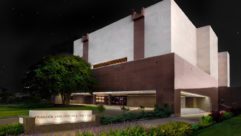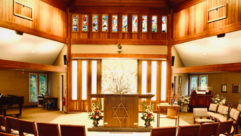Assistive Listening Systems
Jan 1, 2003 12:00 PM,
Nathaniel Hecht
Ensuring the audio experience for all.
Whenever assistive listening systems (ALS) are mentioned in the media, there is usually some reference to the Americans with Disabilities Act (ADA) of 1990 (see the sidebar “Systems Contractors and the ADA.”) The ADA was passed to ensure equal access to public places where goods and services are offered, and its scope covers a variety of disabilities, including people with hearing loss. At that time, the majority of public users for ALS were in the motion picture and live theater markets, and in such places, the ADA laws are designed to work well.
Interestingly, the house of worship market may have felt a greater impact from the use of ALS products, despite the fact that the ADA laws do not implicitly require the use of such equipment, as houses of worship are considered private spaces. The benefits of these systems are fairly obvious, and it’s rather simple for contractors to add ALS in many different venues; however, ALS technology is often left out of the bid specification during the design process. These systems are not at all complex and are generally easy to install, yet more attention should be paid to ALS and the benefits they provide. The additional income from the installation and sale of ALS-related gear offers another excellent reason for contractors to keep these in mind for their next install.
CONCEPTIONS AND MISCONCEPTIONS
Assistive listening technologies became widely available in the 1970s — well before the ADA was signed into law. In those days, systems were used mostly in theaters and rented usually to patrons. There is often a misconception that ALS is useful only for people with hearing impairment. True, those with hearing loss certainly benefit when the overall level of the spoken word, soundtrack, or theatrical performance is increased, allowing the listening device’s user to hear more clearly.
However, what isn’t always clear is that even people with mild hearing loss who do not use a hearing aid or people with healthy hearing can benefit, especially in an environment where the acoustics are less than adequate. ALS is not meant as a solution for poorly designed sound-reinforcement systems. Some contractors and designers believe that including ALS is admitting defeat or inadequacies in design acumen — in reality, including ALS is merely an additional service that can really make a big difference in patrons’ lives.
THE TECHNOLOGIES
Several technologies are used in ALS, and each is distinct and specific to different kinds of applications. Of course, the qualitative differences between transmission categories are small compared with the difference that good mic placement, selection, and attention to proper system setup and maintenance can provide.
The three major categories of ALS transmitters are inductive loop (IL), radio frequency (RF), and infrared (IR); those are fairly similar at their input stages. It’s important to note that regardless of manufacturer or transmission category, each system manufacturer builds accessories and different types of receivers designed to work with these transmitters. I’ll focus on the transmitters in this article, because they are the first choice made when looking at ALS applications in a given venue.
INDUCTIVE LOOP SYSTEMS
IL systems are the earliest technology still in use, with a history dating back to the late 1930s, and they remain fairly popular in Europe. Until recently, IL systems were not as common in the United States as the other technologies, but IL is gaining ground, thanks to the efforts of some dedicated individuals and increased availability of products.
IL systems work by literally surrounding the area to be covered with a large, room-size inductive wire coil, which is often installed at the floor molding level. It can also be wound into walls or placed beneath floors in inductive “floor mats” in preconstruction if the system is specified early in the building process. These mats have internal electromagnetic radiating grids and can be installed under carpeting — an obvious advantage in retrofit installations. The source audio is modulated through coils to produce electromagnetic induction that is picked up by listener hearing aids equipped with telecoil pickups or separate receivers designed to receive induction signals. A powerful driving amplifier feeds the coils.
This technology has evolved over the years. The original design required specific head positioning to hear the signal because of the directionality of the induction field. Modern systems use multiple wires in the grid, which enhance its effectiveness by creating a less directional induction signal. Some drawbacks of this system include signal leakage, which can cause interference in adjacent rooms where other IL systems might be in use, and the issue of privacy because leakage can also cause the signal to be picked up outside of the usage area.
IL systems using grid mats seem to be the most efficient in terms of signal spillover. The 12-by-12-foot grids, which can be linked together to cover larger areas, are best suited for covering small- to medium-size areas because of the cost of equipment and installation as well as long-term maintenance considerations.
RADIO FREQUENCY SYSTEMS
RF systems use a small, single transmitter to cover a circular pattern of at least 300 feet surrounding the antenna with no dead spots or critical positioning issues for the listener. RF can be used indoors or outdoors, is not affected by light or weather, and can cover large areas by using repeater transmitters. A compact battery-powered transmitter can be used in mobile applications such as classrooms or museum tours. RF transmitters get their input signals from mic or line sources and then generate an RF modulated signal through an antenna.
Early systems were amplitude modulated around 480 kHz, but current systems use FM at FCC-allocated frequencies between 72 MHz and 76 MHz that are broken down into 10 wideband channels 200 kHz wide or 40 narrowband channels 50 kHz wide. As to be expected, wideband provides a higher fidelity transmission at the expense of having fewer available channels, whereas narrowband systems are capable of squeezing more simultaneous transmissions into the allocated frequencies with lower fidelity, S/N ratio, frequency bandwidth, and modulated headroom.
Determining the proper RF system depends on the application. Narrowbands are better suited for multiple-channel translation systems and speech range applications, whereas the widebands are a better choice for full-range musical programming. Some manufacturers have added additional frequencies in the 216 MHz band, as well as offerings in the 30 MHz to 45 MHz range. Different transmitter models offer various radiated power output capabilities, but because of FCC-allowable output limits, coverage is limited to about 700,000 square feet, or a radius of about 300 to 500 feet from the transmitter. A coaxial cable connection on many RF models permits the use of external antennas to enhance transmission. For schools and conference rooms, compact portable transmitters are ideal for temporary setups to make locations accessible for the hearing impaired and can also help larger facilities meet ADA obligations without equipping every room in a facility with a permanent system.
INFRARED TRANSMITTERS AND EMITTERS
IR systems use modulated invisible light as a wireless alternative to RF transmissions. The modulated power output causes IR light-emitting diodes (LEDs) pulsing a carrier frequency to frequency modulate. When demodulated by the IR receiver, the deviation from the carrier’s center frequency defines the audio signal. Compared with RF and IL, IR systems can introduce more complexities into the system configuration. The traditional setup consists of a rackmounted transmitter connected by cables to one or more emitters, which essentially are devices containing multiple IR LEDs. The number of emitter panels used varies, depending on the size of the installation and the audience coverage required. In some commercial systems, the emitter enclosures also contain the final output driver circuitry for the banks of individual IR LEDs, and there are alternate form factors available in which all of the transmitter and emitter circuitry is contained in a single panel device superficially resembling the separate emitters.
When IR systems are selected, the contractor must determine the most appropriate installation for a particular venue. IR is a line-of-sight transmission, requiring an unobstructed view between emitter and receiver. It’s also important that a sufficient number of emitters are employed so sufficient optical output is radiated. Multiple emitters at different locations in the room can help increase the odds that at least one emitter will hit the receiver’s optical pickup. This is less of an issue in a fairly small room, but in a large install, the placement of IR emitter panels is critical. Generally, the goal is to wash the area with as much IR light as possible. Portable AC-powered IR transmitters — similar to the RF systems mentioned earlier — are excellent for security-conscious locations, such as smaller courts and jury rooms or in corporate conference rooms.
Almost all IR systems operate in what are called “near-infrared” frequencies of 880 nm or 940 nm. The 880 nm value is closer in spectrum to visible red, so it is best not used in darker environments. The most established carrier frequency is 95 kHz, but because of ballast used in industrial fluorescent lighting, several manufacturers use 250 kHz in mono or as a second channel carrier for IR stereo transmission. New carrier frequencies of 2.3 MHz and 2.8 MHz have also been added to avoid lighting interference. Some IR systems are capable of transmitting on two frequencies at the same time. The one basic rule concerning coverage with multiple carrier frequencies is that the emitter range is diminished by the ratio of the number of frequency carriers transmitted, minus some radiated power to prevent intermodulation between the channels.
NEW APPROACHES, ESTABLISHED TECHNOLOGIES
The product development in ALS is fairly mature, though newer systems are produced at higher efficiencies. This established technology hasn’t changed significantly over the years, with the exception of new accessory options, form factors, mounting configurations, RF options, and more durable materials.
Many manufacturer Web sites offer good information. There are some utilities available for the Renkus-Heinz Ease predictive analysis program (visit www.rh.com for details) that allow positioning and predesign decisions to be made, even before visiting the venue or location. The table, “Comparing Assistive Listening Systems,” provides a listing of products, manufacturers, and pertinent specifications for easy reference.
Nathaniel Hecht is a former editor of S&VC.
For More Information
Ampetronic
www.assistiveaudio.com
Ž 210
Audex
www.audex.com
Ž 211
Auditel
www.auditelcis.co.uk
Ž 212
Califone
www.califone.com
Ž 213
Centrum Sound
www.centrumsound.com
Ž 214
Comtek
www.comtek.com
Ž 215
Gentner
www.gentnerals.com
Ž 216
Lightspeed Technologies
www.lightspeed-tek.com
Ž 217
Listen Technologies
www.listentech.com
Ž 218
Oval Window Audio
www.ovalwindowaudio.com
Ž 219
Oxmoor Corp.
www.oxmoor.com
Ž 220
Phonic Ear
www.phonicear.com
Ž 221
R. L. Drake Company
www.rldrake.com
Ž 222
Sennheiser
www.sennheiserusa.com
Ž 223
Sound Associates
www.soundassociates.com
Ž 224
Sound Choice Assistive Listening
www.synergy-emusic.com/soundchoice.html
Ž 225
Telex
www.telex.com/education
Ž 226
Williams Sound
www.williamssound.com
Ž 227
Ž Circle this number on Reader Service Card or visit freeproductinfo.net/svc









